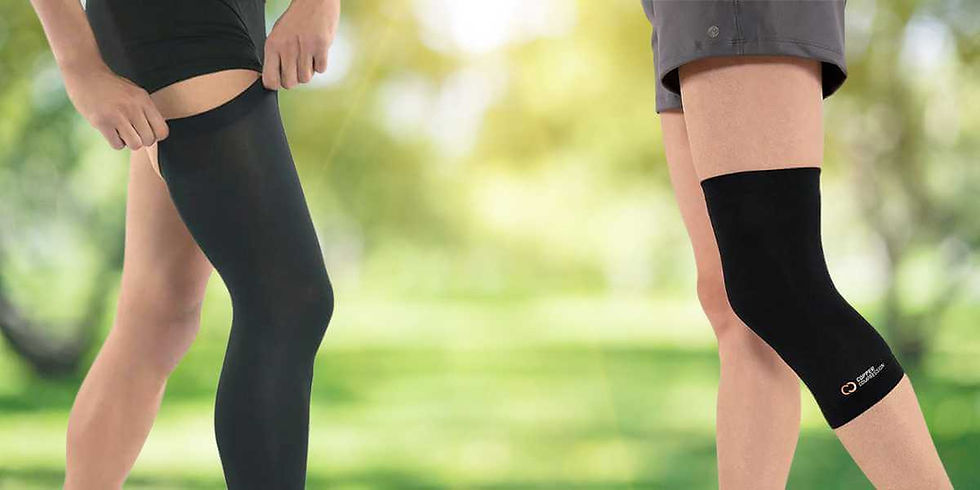Here’s Why Athletes Are Using Red Light Therapy
- Compression Athlete

- Jan 2, 2024
- 4 min read
Updated: Nov 2, 2024
Backed by science, easy to use, and noticeably effective.

From Olympians and professionals to everyday fitness enthusiasts committed to their goals, red light therapy is being adopted by athletes of every sport and stripe.
It’s an easy-to-use therapy that’s performed using low levels of red and near-infrared wavelengths of light to stimulate the body’s natural healing process and boost muscle recovery.
And while red light therapy looks relatively simple in its application (shining red light on an area of your body for a short duration), the results are noticeable and effective.
So, whether you’re a locked-in athlete looking for a competitive edge or simply a fitness enthusiast that doesn’t like to miss a workout, you’re going to want to learn why more and more athletes are incorporating red light therapy into their routines.
Note: Featured products are independently selected and reviewed by Compression Athlete. If you purchase through our links, we may earn commission.
Can Red Light Really Impact Athletic Performance and Recovery?
If you’re a little doubtful about the efficacy of shining red light on your body to boost healing and recovery, it’s understandable.
On the surface, this therapy can look and seem very basic (maybe even a little too simple to be effective).
Not to mention, while you’re performing red light therapy, you feel barely anything at all—just a little warmth on your skin where applied.
Despite this modest appearance, there’s real work occurring at a cellular level.

When low level wavelengths of red and near-infrared light are delivered to your skin tissue, they stimulate mitochondria in your cells.
Mitochondria are commonly known as the powerhouse of the cell, as their main function is to generate the chemical energy necessary to power your cells.
So, when red and near-infrared light stimulate the mitochondria, their energy production increases and allows cells to function more efficiently.
Increasing cell efficiency, increases the cell’s ability to fight infection, accelerate healing and repair, decrease inflammation, and enhance circulation, among other beneficial things.
Or, to put it simply: When our cells have more energy, they perform better, and our bodies perform better as a result.
Athletes use red light therapy to boost muscle recovery.
Yes, that was a lot of science to throw at you, but here’s what it all boils down to for athletes.
We covered how red and near-infrared light stimulate mitochondria to increase cellular function.
And do you know where you can find an abundance of mitochondria in your body?
Muscle tissue.
And it’s this abundance that makes muscle tissue especially responsive to red light therapy.

Athletes that incorporate red light therapy into their routines experience improved athletic performance and faster post-workout recovery.
When it comes to performance, red light therapy has been shown to minimize workout-induced muscle damage, which in turn can boost your endurance.
And as for recovery, red light therapy has been shown to delay the onset of muscle fatigue while also improving circulation, which speeds up your body’s natural recovery process.
Pair these two together (better workouts and faster recovery) and you’re improving your overall strength and athletic ability.
Benefits are achievable in short and convenient sessions.
It’s one of the main reasons why red light therapy continues to grow in popularity.
Not only is red light therapy super easy to perform (simply point at your target area and absorb the light), but it can also be completed in a short amount of time.
In general, the recommend session time for red light therapy is only 5 to 15 minutes a day.
With a high-quality red light therapy device, this amount of time is all you really need to reap the full benefits.

And while you can safely use your red light device for longer, it likely won’t produce additional benefits.
Think of the benefits you obtain from red light therapy as an upside-down U response curve.
There is an optimal peak that is achieved within the 5 to 15 minute range, beyond which the potential to gain any further benefits trails off.
Red light devices are easy to use and adjustable to fit different needs.
Not only can it be applied virtually anywhere on your body, but the popularity of red light therapy has led to innovative devices that provide both targeted and wide-area treatment.
If you’re looking to treat a targeted area on your body, wearable red light devices are a popular choice.

On the other hand, opt for a red light panel if you want to spread the red light benefits to a larger surface area of your body.
To get a sense of which red light device would best fit your needs, check out our list of the Best Red Light Devices for Athletes.

And while red light therapy has surged in popularity among athletes for muscle recovery, it can also be used to address other conditions and injuries, including sprains, strains, localized pain, tendonitis, and much more.
Keep in mind that it’s consistent use over time that will help you reap the full benefits of this therapy.
Athletes that incorporate red light therapy into their routines experience faster recovery times, less muscle soreness, better sleep, enhanced muscle tone, and an improved general well-being.
And for everything else there is to know about red light therapy, check out our complete guide.



























